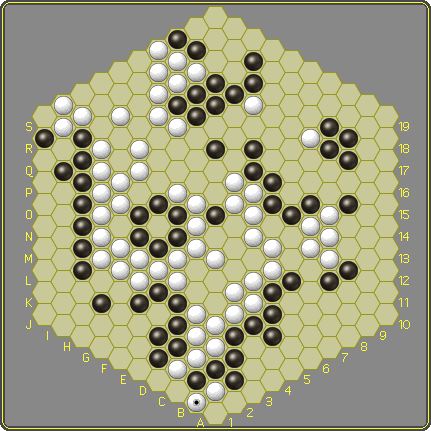 |
Definitions Two stones, or a stone and an empty cell, see each other if they lie on the same straight line of adjacent cells and there are no other stones between them along that line. You control a cell if the number of stones of your color it sees is more than half the number of cells (empty or occupied) adjacent to it. This means thay you - control a centre cell if it sees 4 or more stones of your colour - control an edge cell if it sees 3 or more stones of your colour - control a corner cell if it sees 2 or more stones of your colour To flip a stone is to replace it with a stone of the opposite color. |
Play
Black plays first, then turns alternate. On your turn, perform exactly one of the following actions:
- Pass, provided that there are no empty cells or every empty cell is controlled by some player.
Note: to pass a turn (when allowed) in the MindSports app, click on one of your stones. - Place a stone of your color on an empty cell not controlled by your opponent.
- Flip an enemy stone on a cell you control.
The game ends when both players pass in succession. The player with the higher score in the final position wins.
Your score is the number of stones of your color on the board, plus the number of empty cells you control, plus a komi in the case of White. The button is used to avoid ties.
Komi and button
The komi is the whole number of points which is added to White's score at the end of the game as a compensation for playing second. Before the game starts, the first player chooses the value of komi, and then the second player chooses sides. Alternatively, experienced players may agree on a standard value for all games.
Note: in the MindSports Player Sections the komi and who plays first are set by the challenger. The challengee can accept or reject the challenge, but that's all. So coordination on komi and sides needs to be done beforehand, or refrained from altogether.
The button is a special token which is placed next to the board at the start of the game. It is only used when komi is an odd number. On your turn, if neither player has taken the button yet, you may not pass, but you may take the button instead of making a board play. At the end of the game, a half point is added to the score of the player who has taken the button.
